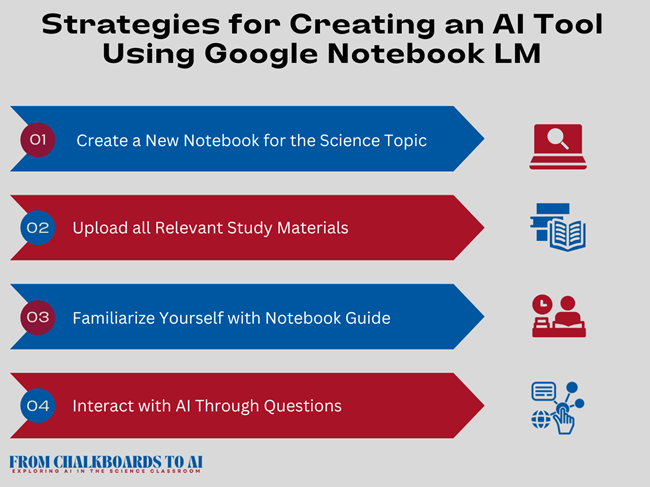From Chalkboards to AI
Agentic AI: Developing the Benefits for Classroom Learning – Part I
By Christine Anne Royce, Ed.D. and Valerie Bennett, Ph.D., Ed.D.
Posted on 2025-05-12

Disclaimer: The views expressed in this blog post are those of the author(s) and do not necessarily reflect the official position of the National Science Teaching Association (NSTA).
Have you ever wished there was a little voice that could help students study, explain tough topics, quiz them before an assessment, or break down complex ideas into bite-sized pieces? That’s the magic of agentic AI—and it’s not science fiction. It’s happening right now.
What Is Agentic AI, anyway?
Agentic AI sounds like it stepped out of a futuristic novel, but it's actually a pretty grounded concept. According to the Harvard Business Review, Agentic AI “refers to AI systems and models that can act autonomously to achieve goals without the need for constant human guidance. The agentic AI system understands what the goal or vision of the user is and the context to the problem they are trying to solve” (Purdy 2024).
At its core, agentic AI refers to artificial intelligence systems that act as agents—they have a goal, they make decisions to achieve that goal, and they interact with users and environments in a more intentional way. The fact that agentic AI understands what the goal is and how to help the user obtain that goal is is novel, useful, and to a point, a bit scary.
You may have already encountered chatbots that can assist you in answering your questions, but they are limited. For example, if you have contacted a customer service center outside of normal operating hours, the little chatbot helper pops up and asks, “How can I help you?” You can go just so far before realizing that you need more assistance or help than the chatbot can provide. Agentic AI does more. It doesn’t just wait to be asked—it plans, adapts, nudges, and even takes initiative.
Imagine an AI science study assistant that notices you’re struggling with the law of superposition related to the age of the Earth. It might suggest you review stratification, how intrusions and faulting can occur, as well as the fossil record, before moving to the next concept, or even recommend a simulation to help you visualize it. It might even quiz you daily, based on your weak spots. That’s agentic behavior—goal-driven, personalized, and proactive. (Disclaimer: We always want students engaging in three-dimensional learning and participating in the actual application of science concepts. There are points, however, that reviewing concepts may be needed, and AI agents can be useful.)
Why This Matters for Science Students
Science isn’t about memorizing facts. It’s about employing science and engineering practices, using logic, engaging in experimentation, and applying concepts in new situations. That’s why it can be challenging for many students, especially when trying to review their understanding individually.
Agentic AI chat agents can:
- Provide on-demand tutoring assistance without time limits or scheduling conflicts.
- Offer step-by-step explanations with visuals, simulations, or even analogies based on student interests.
- Personalize the learning path. If a student gets confused between kinetic and potential energy, the agent can focus on reinforcing that.
- Motivate! A little encouragement and recognition of progress can go a long way.
In short, an agentic chat agent can meet students where they are, and help them get where they want to be. This does NOT mean AI replaces teachers. Rather, teachers need to be able to design and build the agent that will assist the student.
Building a Chat Agent: The Big Picture
With the tools available today, educators or students with basic tech skills can start creating agentic AI chat assistants. We are going to break this concept down into two parts. The first is using a tool that is not a full-fledged AI agent, but provides an initial experience to help set up some resources for students. Let’s go through a high-level roadmap.
Step 1: Define the Agent’s Purpose and Personality
Don't try to tackle all of science at once. Start with a well-defined area, as this will make the project more manageable. Start by answering a few questions:
- What age or grade level is your agent meant for? (e.g., middle school science, high school physics, or college-level biology?)
- What should the agent do? (Explain concepts? Quiz students? Recommend videos or experiments?) This is often referred to as the core study features which has several potential purposes.
- Information Retrieval: Answering factual questions about the topic.
- Concept Explanation: Breaking down complex ideas into simpler terms.
- Practice Questions: Generating quizzes and problems.
- Feedback and Hints: Providing guidance on practice questions.
- Summarization: Condensing key information from texts or notes.
- Personalized Learning Paths: Adapting to the student's understanding.
- How should it sound? (Friendly and funny? Calm and scholarly? Maybe something in-between?)
Let’s say your agent is for 8th-grade science and helps students understand Earth science topics. You could give it a name like the SciencePal and an enthusiastic, slightly quirky supportive personality—just enough to keep things engaging.
Step 2: Choose Your Tools
Now comes the tech part, which is not nearly as bad as you might think. You will need to consider how the user interacts with or interfaces with the agent. This is referred to as user Interface (UI). Questions to consider are: will it be through text-based chat, a graphical interface with buttons, or something else? It is best to keep it simple and intuitive for now. While different tools can be used to build, we propose using Google Notebook LM to start with for several reasons. First, it is already very intuitive due to the high use of Google tools, although it isn’t a complete AI agent development platform. Second, it allows you to curate the resources you want it to utilize in interacting with the students. Finally, it can easily produce resources such as study outlines for students.

Step 3: Create a Knowledge Base
The knowledge base is where the agent will draw its information from as it interacts with the user. It is important to keep in mind that the content, which can be anything from Google Docs and Slides to PDFs to URLs to YouTube Videos, needs to be carefully curated by the teacher. There is an old computer adage that goes “Garbage In, Garbage Out” that certainly applies to this task. Selectively and carefully creating a repository is important.
- Create a New Notebook for the Science Topic: Organize your study materials by creating a dedicated notebook for the specific science topic.
- Upload All Relevant Study Materials: Gather all your textbooks, notes, articles, and other resources for that topic and upload them into the notebook. Ensure the information is as accurate and comprehensive as possible. Remember to never include identifying information about students.
- Familiarize Yourself with the Notebook Guide: Once your sources are uploaded, NotebookLM will automatically generate a Notebook Guide with a summary of the content and suggested questions. This gives you a quick overview of what the AI has understood.
- Interact with the AI Through Questions: There was a video years ago called “How to Train Your Dragon.” Picture that as you start asking the AI specific questions a student might have while studying the topic. For example:
- Explain the process of photosynthesis in simple terms.
- What are the key differences between mitosis and meiosis?
- Can you summarize the main theories of plate tectonics?
- What are some real-world applications of Ohm's Law?
- Utilize the Studio Panel for Generating Study Aids: Use the Studio panel on the right-hand side to generate study guides, FAQs, and other helpful documents based on your uploaded materials. Review and refine these materials as needed.
- Experiment with Different Prompts: Try different ways of asking questions and giving prompts to see how NotebookLM responds. You can ask it to:
- Explain a concept in a specific way (e.g., Explain it like I'm a high school student).
- Compare and contrast different ideas.
- Provide examples.
- Iterate and Refine Your Notebook: As students use the tool, ask them to identify areas where the agent could be more helpful. As they do so, you can:
- Upload additional materials.
- Refine your questions and prompts.
- Edit the generated study aids.
As noted above, this is the first step in designing a platform to help, and does not include all of the bells and whistles that a full AI agent can provide. The major limitation of using Google Notebook LM, beyond it not being a fully autonomous agent builder, is that it might be challenged with very open-ended or creative tasks. NotebookLM does not offer the same type of learning personalization a custom-built AI agent might offer, such as those found in online programs like Khan Academy.
Conclusion
Google NotebookLM is a valuable tool for designing a study assistant, particularly for its ability to understand and synthesize information from your learning materials and to generate helpful study aids. While it might not have all the features of a dedicated AI agent development platform, its strengths in knowledge organization, question answering based on provided content, and study material generation make it a powerful asset for students. You can effectively use it as the core "brain" of your study agent by feeding it the necessary knowledge and interacting with it to mimic how a student would ask for help.
References
Purdy, M. (2024, December 12). What is agentic ai, and how will it change work? Harvard Business Review. https://hbr.org/2024/12/what-is-agentic-ai-and-how-will-it-change-work
 Christine Anne Royce, Ed.D., is a past president of the National Science Teaching Association and currently serves as a Professor in Teacher Education and the Co-Director for the MAT in STEM Education at Shippensburg University. Her areas of interest and research include utilizing digital technologies and tools within the classroom, global education, and the integration of children's literature into the science classroom. She is an author of more than 140 publications, including the Science and Children Teaching Through Trade Books column.
Christine Anne Royce, Ed.D., is a past president of the National Science Teaching Association and currently serves as a Professor in Teacher Education and the Co-Director for the MAT in STEM Education at Shippensburg University. Her areas of interest and research include utilizing digital technologies and tools within the classroom, global education, and the integration of children's literature into the science classroom. She is an author of more than 140 publications, including the Science and Children Teaching Through Trade Books column.
Valerie Bennett, Ph.D., Ed.D., is an Assistant Professor in STEM Education at Clark Atlanta University, where she also serves as the Program Director for Graduate Teacher Education and the Director for Educational Technology and Innovation. With more than 25 years of experience and degrees in engineering from Vanderbilt University and Georgia Tech, she focuses on STEM equity for underserved groups. Her research includes AI interventions in STEM education, and she currently co-leads the Noyce NSF grant, works with the AUC Data Science Initiative, and collaborates with Google to address CS workforce diversity and engagement in the Atlanta University Center K–12 community.
Note: This article is part of the blog series From Chalkboards to AI, which focuses on how artificial intelligence can be utilized within the classroom in support of science as explained and described in A Framework for K–12 Science Education and the Next Generation Science Standards.
Click here for Part II: Agentic AI: Developing the Benefits for Classroom Learning—Part II
The mission of NSTA is to transform science education to benefit all through professional learning, partnerships, and advocacy.


